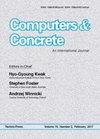不同埋深NSM FRP筋加固负弯矩区钢筋混凝土t梁的数值研究
IF 3.3
4区 工程技术
Q2 COMPUTER SCIENCE, INTERDISCIPLINARY APPLICATIONS
引用次数: 7
摘要
近年来,应用近表面安装(NSM)方法通过使用纤维增强聚合物(FRP)棒对受弯钢筋混凝土(RC)构件进行加固已成为设计人员和研究人员感兴趣的课题。该技术已经得到了广泛的应用,但仍需要更多的实验、分析和数值研究来确定其参数对钢筋混凝土构件抗弯性能的影响。因此,本研究建立了详细的三维非线性有限元数值模型,通过不同埋深的NSM FRP棒放置在三点弯曲荷载下,准确预测负弯矩区加固的RC t梁的承载能力和响应。在设计模型时,充分考虑了混凝土的非线性本构材料特性、钢筋屈服、NSM棒和内聚行为,模拟了相邻两种材料之间的接触。此外,数值模拟的结果与其他研究者的实验结果进行了比较,这些实验是在一个未加固的对照试件上添加NSM FRP棒加固的两个试件。然而,结果表明,在所有弯曲加载阶段,预测有限元的跨中挠度响应与实验数据相一致。随后使用验证的有限元模型来分析FRP材料的几种特性的影响,以提供比有限的实验数据更多的信息。结果表明,所建立的有限元模型具有较强的实用性和经济性,更注重基于设计的参数化研究,对NSM FRP棒加固钢筋混凝土构件的负弯矩进行精确建模和分析。本文章由计算机程序翻译,如有差异,请以英文原文为准。
Numerical investigation on RC T-beams strengthened in the negative moment region using NSM FRP rods at various depth of embedment
The application of Near Surface Mounted (NSM) method to strengthen reinforced concrete (RC) members in flexure through the use of Fiber Reinforced Polymer (FRP) rods has become a subject of interest to designers and researchers over the past few years. This technique has been extensively applied, and there is still a need for more experiments, analytical, and numerical studies to determine the effects of their parameters on the flexural performance of RC members. Therefore, a detailed 3D nonlinear finite element (FE) numerical model was developed in this study to predict the load-carrying capacity and the response of RC T-beams strengthened in the negative moment region accurately through the use of NSM FRP rods at different depth of embedment which are placed under three-point bending loading. The model was, however, designed with due consideration for the nonlinear constitutive material properties of concrete, yielding of steel reinforcement, NSM rods, and cohesive behaviors to simulate the contact between two neighboring materials. Moreover, the findings of the numerical simulations were compared with those from the experiments by other investigators which involve two specimens strengthened with NSM FRP rods added to one unstrengthened control specimen. The results, however, showed that the mid-span deflection responses of the predicted FE were in line with the corresponding data from the experiment for all the flexural loading stages. This was followed by the use of the validated FE models to analyze the effect of several properties of the FRP materials to provide more information than the limited experimental data available. It was discovered that the FE model developed is appropriate to be applied practically and economically with more focus on the parametric studies based on design to precisely model and analyze flexural negative moment strengthening for the RC members through the use of NSM FRP rods.
求助全文
通过发布文献求助,成功后即可免费获取论文全文。
去求助
来源期刊

Computers and Concrete
工程技术-材料科学:表征与测试
CiteScore
8.60
自引率
7.30%
发文量
0
审稿时长
13.5 months
期刊介绍:
Computers and Concrete is An International Journal that focuses on the computer applications in be considered suitable for publication in the journal.
The journal covers the topics related to computational mechanics of concrete and modeling of concrete structures including
plasticity
fracture mechanics
creep
thermo-mechanics
dynamic effects
reliability and safety concepts
automated design procedures
stochastic mechanics
performance under extreme conditions.
 求助内容:
求助内容: 应助结果提醒方式:
应助结果提醒方式:


